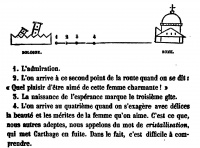Stendhal
From The Art and Popular Culture Encyclopedia
| Revision as of 06:31, 6 January 2014 Jahsonic (Talk | contribs) (→Works) ← Previous diff |
Revision as of 06:31, 6 January 2014 Jahsonic (Talk | contribs) (→See also) Next diff → |
||
| Line 64: | Line 64: | ||
| ==See also== | ==See also== | ||
| * [[Stendhal syndrome]] | * [[Stendhal syndrome]] | ||
| + | *[[Mononymous persons]] | ||
| {{GFDL}} | {{GFDL}} | ||
Revision as of 06:31, 6 January 2014
| Kant's famous definition of the beautiful. "That is beautiful," says Kant, "which pleases without interesting." Without interesting! Compare this definition with this other one [..] by Stendhal, who once called the beautiful une promesse de bonheur. Here, at any rate, the one point which Kant makes prominent in the aesthetic position is repudiated and eliminated—le désinteressement. Who is right, Kant or Stendhal? --Nietzsche, On the Genealogy of Morality |
|
Related e |
|
Featured: |
Marie-Henri Beyle (January 23, 1783 – March 23, 1842), better known by his pen name Stendhal, was a 19th-century French writer. Known for his acute analysis of his characters' psychology, he is considered one of the earliest and foremost practitioners of realism in his two novels Le Rouge et le Noir (The Red and the Black, 1830) and La Chartreuse de Parme (The Charterhouse of Parma, 1839).
Contents |
Crystallization
In Stendhal's 1822 classic On Love he describes or compares the “birth of love”, in which the love object is 'crystallized' in the mind, as being a process similar or analogous to a trip to Rome. In the analogy, the city of Bologna represents indifference and Rome represents perfect love:
When we are in Bologna, we are entirely indifferent; we are not concerned to admire in any particular way the person with whom we shall perhaps one day be madly in love; even less is our imagination inclined to overrate their worth. In a word, in Bologna “crystallization” has not yet begun. When the journey begins, love departs. One leaves Bologna, climbs the Apennines, and takes the road to Rome. The departure, according to Stendhal, has nothing to do with one’s will; it is an instinctive moment. This transformative process actuates in terms of four steps along a journey:
- Admiration – one marvels at the qualities of the loved one.
- Acknowledgement – one acknowledges the pleasantness of having gained the loved one's interest.
- Hope – one envisions gaining the love of the loved one.
- Delight – one delights in overrating the beauty and merit of the person whose love one hopes to win.
This journey or crystallization process (shown above) was detailed by Stendhal on the back of a playing card while speaking to Madame Gherardi, during his trip to the Salzburg salt mine.
Stendhal syndrome
In 1817 Stendhal reportedly was overcome by the cultural richness of Florence he encountered when he first visited the Tuscan city. As he described in his book Naples and Florence: A Journey from Milan to Reggio:
As I emerged from the porch of Santa Croce, I was seized with a fierce palpitation of the heart (that same symptom which, in Berlin, is referred to as an attack of the nerves); the well-spring of life was dried up within me, and I walked in constant fear of falling to the ground.
The condition was diagnosed and named in 1979 by Italian psychiatrist Dr. Graziella Magherini, who had noticed similar psychosomatic conditions (racing heart beat, nausea and dizziness) amongst first-time visitors to the city.
In homage to Stendhal, Trenitalia named their overnight train service from Paris to Venice the Stendhal Express.
Works
Novels
- Armance (1827)
- Le Rouge et le Noir (variously translated as Scarlet and Black, Red and Black, The Red and the Black, 1830)
- La Chartreuse de Parme (1839) (The Charterhouse of Parma)
- Lucien Leuwen (1835, unfinished, published 1894)
- Lamiel (1839-42, unfinished, published 1889)
Autobiography
- The Life of Henry Brulard (1835-1836, published 1890)
Biography
- A Life of Napoleon (1817-1818, published 1929)
Novellas
- The Pink and the Green (1837, unfinished)
- Mina de Vanghel (1830, later published in La Revue des Deux Mondes)
- Vittoria Accoramboni
- Italian Chroniques, 1837 — 1839
- The Cenci (Les Cenci)
- The Duchess of Palliano (La Duchesse de Palliano)
- The Abbess of Castro (L'Abbesse de Castro, 1832)
- Vanina Vanini
Essays
- De L'Amour (1822) (On Love)
- Souvenirs d'Égotisme (Memoirs of an Egotist, published in 1892)
His other works include short stories, journalism, travel books (among them Rome, Naples et Florence and Promenades dans Rome), a famous collection of essays on Italian painting, critical essays on Racine and Shakespeare, and biographies of several prominent figures of his time, including Napoleon, Haydn, Mozart, Rossini, and Metastasio.
See also


